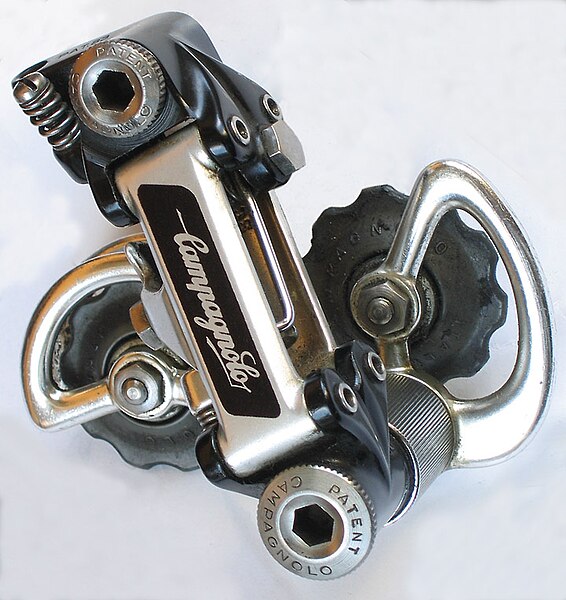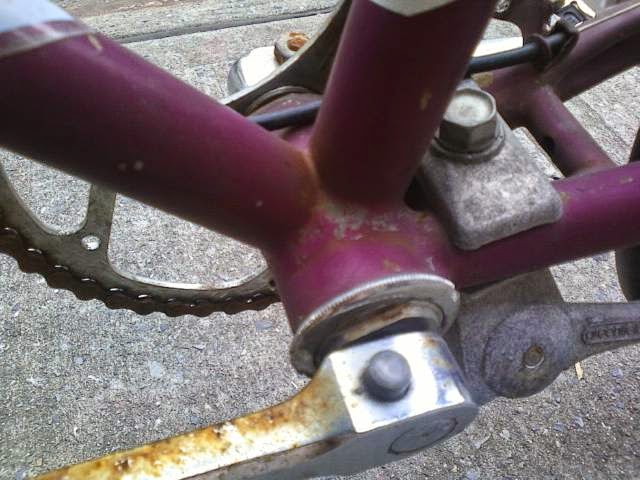You know that something is influential is when it is imitated--even after the original is no longer made.
Several bicycle derailleurs come immediately to mind. If you're of my generation, one is the Campagnolo Nuovo/Super Record. From the time the first Nuovo was made in 1967 until the last Super Record came out of the Vicenza plant two decades later, innumerable parts manufacturers copied its basic design. Much of the reason for that was, of course, the preponderance of Campagnolo equipment in the elite pelotons of the world. "If Eddy won the Tour with it, it must be the best," is what those imitators were probably thinking.
Some will stop reading this post (and, possibly, this blog) after reading what I'm about to write: The Campagnolo Nuovo/Super Record, even when it was introduced, was not the best-shifting derailleur available. What caused its domination at the top of the cycling world was its reliability and, well, the reputation Campagnolo built with their earlier derailleurs and other components. Also, each derailleur (more so the Nuovo, in my opinion) had a "classic" look to it.
As I mentioned in an earlier post, when the GDR government decided it needed to bring bicycle technology up to the level of what existed in the West, one of the parts they produced was a Tectoron derailleur that, from ten meters away, looks like a Campagnolo Super Record without the logos.
Another influential derailleur was the Huret Svelto. In its time, it was rather nice: The shifting was better (or, at least, no worse) than most other derailleurs that were available when it was introduced in 1963. And it had a certain industrial-minimalist aesthetic. (Think of a "cold irons bound" version of the Jubilee.) But the main reason why it was widely imitated--even Shimano and SunTour had versions, called the "Pecker" and "Skitter" respectively--was that it was made from pressed steel plates riveted together. In other words, it was cheap to manufacture. Through the 1970s, various component makers--including Romet of Poland--were making derailleurs that looked (and shifted) like the Svelto.
(In contrast to the Svelto, the Huret Allvit--which may have come as original equipment on more bicycles than any other rear derailleur in history--had, as far as I know, only one imitator: the USA-made Excel Dynamic of 1975-77. It's particularly odd that, as the first American derailleur, its manufacturer would almost slavishly copy the Allvit when many cyclists were replacing their Allvits with SunTour and Shimano derailleurs.)
Today, if you asked what derailleur is the most influential, the answer you'd probably get is "Shimano". No specific model would be mentioned, as nearly all derailleurs made by that company over the past thirty years share the same basic "slant pantograph" design with two sprung pivots. Neither of those features is, of course, a Shimano innovation: SunTour introduced the former in its 1964 "Gran Prix" derailleur, and Simplex first employed the latter feature on a parallelogram derailleur when it made the "Juy Export 61."
Since all but the lowest-cost derailleurs today use both features, perhaps we could say that the Sun Tour Gran Prix (or, perhaps the SunTour Competition, which came out a year later and eliminated the Gran Prix's less-desirable features) and the Simplex Juy Export 61 are the most influential derailleurs in the bicycle world today, even though neither has been made in decades.
The funny thing is that the influence of those two derailleurs--and others from SunTour and Simplex--still lives on even in derailleurs found on the cheapest department store bikes. Shimano's less-expensive derailleurs, with the dropped rather than the slant parallelogram, continue to employ two sprung pivots reminiscent of Simplex. Perhaps even more ironically, Shimano is apparently making a derailleur that apes the SunTour "Honor" and "U" derailleurs found on low-priced bikes during the 1970's:
I saw this derailleur on a bike parked near where I work. I'd never seen it before. The only difference between the Shimano in the photo and the lowest-priced SunTours of the 1970s seems to be the black plastic front knuckle and that the rear knuckle, parallelogram plates and the part that holds the top pivot seem to be more crudely stamped and finished--and possibly made from a lower grade of steel--than those old SunTour base models.
Those inexpensive SunTours shifted nearly as well as, but developed play in the pivots more quickly than, the V-series SunTours. (Sometimes the Sun Tour "U" was the only good component on the bike that came with it!) I wonder how that Shimano derailleur I saw today shifts.
| Mavic 851 rear dearailleur, circa 1981. Photo from Velobase |
Several bicycle derailleurs come immediately to mind. If you're of my generation, one is the Campagnolo Nuovo/Super Record. From the time the first Nuovo was made in 1967 until the last Super Record came out of the Vicenza plant two decades later, innumerable parts manufacturers copied its basic design. Much of the reason for that was, of course, the preponderance of Campagnolo equipment in the elite pelotons of the world. "If Eddy won the Tour with it, it must be the best," is what those imitators were probably thinking.
 |
| Campagnolo Super Record, circa 1983. From Wikipedia Commons |
| Campagnolo Nuovo Record. From Sheldon Brown's Bicycle Glossary. |
Some will stop reading this post (and, possibly, this blog) after reading what I'm about to write: The Campagnolo Nuovo/Super Record, even when it was introduced, was not the best-shifting derailleur available. What caused its domination at the top of the cycling world was its reliability and, well, the reputation Campagnolo built with their earlier derailleurs and other components. Also, each derailleur (more so the Nuovo, in my opinion) had a "classic" look to it.
| Kharkov rear derailleur. Probably the sorriest imitation of Campy NR/SR--with the possible exception of the Gian Robert--ever made. Photo from Velobase. |
As I mentioned in an earlier post, when the GDR government decided it needed to bring bicycle technology up to the level of what existed in the West, one of the parts they produced was a Tectoron derailleur that, from ten meters away, looks like a Campagnolo Super Record without the logos.
| Huret Svelto. From Bulgier.net |
Another influential derailleur was the Huret Svelto. In its time, it was rather nice: The shifting was better (or, at least, no worse) than most other derailleurs that were available when it was introduced in 1963. And it had a certain industrial-minimalist aesthetic. (Think of a "cold irons bound" version of the Jubilee.) But the main reason why it was widely imitated--even Shimano and SunTour had versions, called the "Pecker" and "Skitter" respectively--was that it was made from pressed steel plates riveted together. In other words, it was cheap to manufacture. Through the 1970s, various component makers--including Romet of Poland--were making derailleurs that looked (and shifted) like the Svelto.
| Romet derailleur, Poland, 1970s. Photo from Disraeligears |
(In contrast to the Svelto, the Huret Allvit--which may have come as original equipment on more bicycles than any other rear derailleur in history--had, as far as I know, only one imitator: the USA-made Excel Dynamic of 1975-77. It's particularly odd that, as the first American derailleur, its manufacturer would almost slavishly copy the Allvit when many cyclists were replacing their Allvits with SunTour and Shimano derailleurs.)
| 1964 SunTour Gran Prix. Photo from Disrealigears |
Today, if you asked what derailleur is the most influential, the answer you'd probably get is "Shimano". No specific model would be mentioned, as nearly all derailleurs made by that company over the past thirty years share the same basic "slant pantograph" design with two sprung pivots. Neither of those features is, of course, a Shimano innovation: SunTour introduced the former in its 1964 "Gran Prix" derailleur, and Simplex first employed the latter feature on a parallelogram derailleur when it made the "Juy Export 61."
| Simplex Juy Export 61. Photo from Cycles Cambio (Japanese blog) |
Since all but the lowest-cost derailleurs today use both features, perhaps we could say that the Sun Tour Gran Prix (or, perhaps the SunTour Competition, which came out a year later and eliminated the Gran Prix's less-desirable features) and the Simplex Juy Export 61 are the most influential derailleurs in the bicycle world today, even though neither has been made in decades.
| SunTour "U" derailleur. Photo from Disraeligears |
| SunTour Honor. Photo from Bikeforums |
The funny thing is that the influence of those two derailleurs--and others from SunTour and Simplex--still lives on even in derailleurs found on the cheapest department store bikes. Shimano's less-expensive derailleurs, with the dropped rather than the slant parallelogram, continue to employ two sprung pivots reminiscent of Simplex. Perhaps even more ironically, Shimano is apparently making a derailleur that apes the SunTour "Honor" and "U" derailleurs found on low-priced bikes during the 1970's:
I saw this derailleur on a bike parked near where I work. I'd never seen it before. The only difference between the Shimano in the photo and the lowest-priced SunTours of the 1970s seems to be the black plastic front knuckle and that the rear knuckle, parallelogram plates and the part that holds the top pivot seem to be more crudely stamped and finished--and possibly made from a lower grade of steel--than those old SunTour base models.
Those inexpensive SunTours shifted nearly as well as, but developed play in the pivots more quickly than, the V-series SunTours. (Sometimes the Sun Tour "U" was the only good component on the bike that came with it!) I wonder how that Shimano derailleur I saw today shifts.










